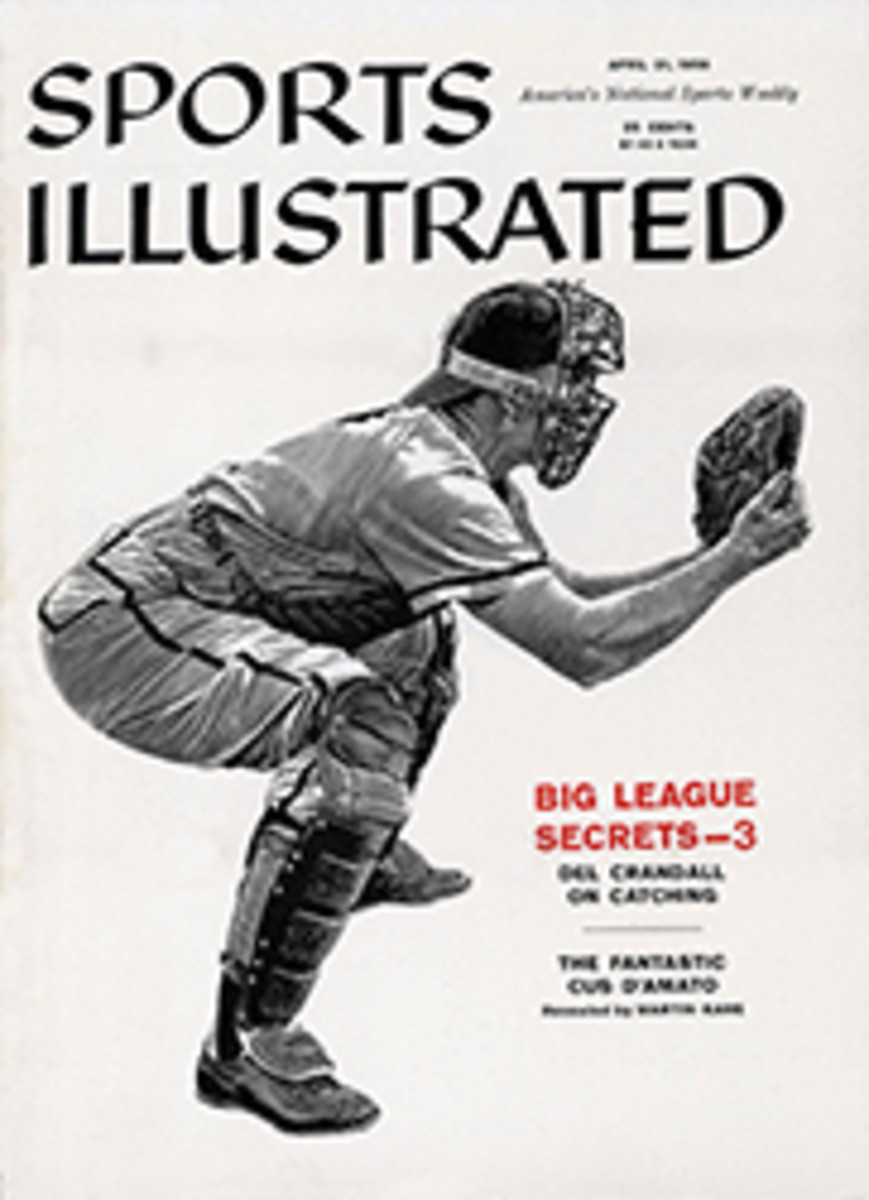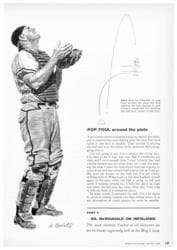
BRITAIN'S 'SCEPTRE' TAKES TO SEA
White-hulled and lovely under a warm April sun, the 12-meter yacht Sceptre beat her way slowly down Scotland's Holy Loch, threading past rusting freighters laid up there, heading for the open Firth of Clyde. The date was April 11, and Britain's brand-new challenger for the America's Cup, the first in 21 years, was making her debut under sail.
In the 107 years since the schooner America first took the Cup from England and gave it her name, British boats have 16 times attempted—and 16 times failed—to bring it back to English shores. The list of challengers is an illustrious one, from Galatea and Valkyrie through Sir Thomas Lipton's five Shamrocks to T.O.M. Sopwith's two Endeavours; but among them Sceptre is unique. Not only because she is the first to challenge under the amended Deed of Gift allowing 12-meters as the Cup Class in place of the lordly J boats, but because she is uniquely a product of British pride, British hopes and British capital scratched together in a tax-racked era.
Hugh Goodson, chairman of the 11-man Royal Yacht Club Syndicate which built her, recalled the start of her story:
"I was sitting in my car outside the Royal Dart Yacht Club with Lord Runciman in, I think, September 1956, when I told him that I intended to form a syndicate to build a challenger. He said he would like to join me, and so it all began."
Other members of the syndicate were found with little difficulty, despite the fact that some members of the RYS were more than skeptical of the whole idea of challenging again. All told, 11 men (see left and below) pooled their resources to build Sceptre. Besides Hugh Goodson, there were Viscount Runciman, Viscount Camrose, Lieut. Colonel Arthur Ac-land, H. A. Andreae, Captain Bertram Currie, Group Captain Loel Guinness, Major Harold Hall, Major R. N. Macdonald-Buchanan, Charles Wainman and Sir Peter Hoare. Lieutenant Colonel R. S. G. Perry was brought in as technical adviser; an Olympic 5.5-meter sailor who won a silver medal in Melbourne, he advocated the earliest possible challenge. Once the U.S. got down to it, he pointed out, overwhelming financial resources could be brought into play, so Britain's only hope was to try to catch the defenders off balance.
On December 16, 1956 the New York State Supreme Court amended the Deed of Gift and the syndicate went into action. Four designers-David Boyd, Charles A. Nicholson, James McGruer and Arthur Robb—were asked to submit two designs each for tank testing. The designs were to be ready for April 1—"an appropriate date," as one persistent skeptic jokingly remarked. On May 14, 1957, after the conditions had been agreed on with the New York Yacht Club, the challenge was made. On April 2, 1958, one year and one day after the first designs had been submitted, Sceptre slid down the ways.
It was David Boyd, the tall, silver-haired Scotsman who learned his craft at the famous Yard of Fifes at Fairlie, who won the plum of creating her. His "B" model was picked on July 13, 1957, and work began at once at Alexander Robertson & Sons, on the Holy Loch, where Boyd is managing director. "She'll have to be ready in early April if the crew are to have a decent chance," he said. By October the full-size drawings were laid out, the materials ordered—wood from four different firms, steel frames, the mold for the casting of the keel. Gold sovereigns went into the mold for luck along with the molten lead.
In a couple of months the frames, alternate mild steel and laminated wood, were in place and the mahogany planking started. This was completed in mid-February, and Boyd was able to tell the press, who were allowed into the shed for the first time, "She'll be ready for launching on April 2."
Some criticized the secrecy surrounding the building, but this had a purpose. "Ye canna wurrk with strangers breathing doon y'r neck," said a shipwright, one of the 24 picked craftsmen who worked on Sceptre under 72-year-old Foreman Sam Auld, a veteran of 40 years with Robertson's. For all the men in the team the challenger was something special. "I wish I had another month," said one, "I could make her look real decent."
Of course there were delays and snags, but with the designer on the spot these could be quickly ironed out, even if it meant his working 14 hours a day for many months. "You've got to find what is practicable within the time," said Boyd in the early stages. "You can't just open a catalog and order a set of fittings. Each has to be made individually."
In August, before the building started, Perry had resigned as technical adviser. An impetuous perfectionist who had owned a number of boats himself, he found working on the team too frustrating. He was replaced by Commander Sam Brooks, a wartime submarine officer. He was in charge of the Navy yacht Marabu in the 1952 Bermuda and transatlantic races and will be in charge of Sceptre's crew during the tuning up and the Cup races.
Sceptre's 90-foot alloy mast was made by Camper & Nicholson's at Gosport, after Boyd's drawings had been checked by the stress experts of the Hawker Siddeley aircraft group. The chairman of this concern is Sir Thomas Sopwith, of the Endeavours.
Meanwhile in the yard the deck had been laid. It is cambered, as is Vim's, to get the sail plan as high as the maximum of the class limit of 82 feet from the deck can be. The internal arrangement has racing efficiency and weight saving as the main considerations. Even Sceptre's plumbing is of polythene instead of copper tubing.
Her Cup race sails of Terylene are still being built in George Colin Ratsey's lofts at Cowes and Gosport, but some details of her rig and running gear were, of course, clearly evident in her first run under sail. Her alloy mast is held by streamlined steel shrouds over one set of crosstrees, with one jumper strut, a rigging plan that does not look as frightening as it sounds. An interesting innovation is the color coding of the rope used for her sheet and halyard tails: blue, green, white, red and yellow.
It is doubtful if anyone will ever know how much this boat has cost. We who watched her under sail, a slim white gull of a boat heeling to the freshening winds, recalled the words of the pundits at her launching. Said Stan Bishop, the professional skipper of Evaine, against which Sceptre will be sailed in her tune-up cruises: "I reckon she'll be faster than Vim in a breeze." He had raced against the famous U.S. 12-meter, one of the contenders for the honor of defending the Cup starting September 20, when Harold S. Vanderbilt cleaned up in England with her in 1939.
Said Ewing McGruer, an old sage eying her clean run: "She'll be a flyer in light weather."
Said David Boyd: "The work is just beginning."
PHOTO
HUGH GOODSON, SYNDICATE CHAIRMAN
PHOTO
HERMAN A. ANDREAE
PHOTO
CAPTAIN BERTRAM FRANCIS G. CURRIE
PHOTO
JOHN SEYMOUR BERRY VISCOUNT CAMROSE
PHOTO
VISCOUNT RUNCIMAN OF DOXFORD
PHOTO
CHARLES WAINMAN
PHOTO
MAJOR REGINALD N. MACDONALD-BUCHANAN
PHOTO
SIR PETER HOARE
PHOTO
GROUP CAPTAIN T. LOEL E. B. GUINNESS
PHOTO
LIEUTENANT COLONEL ARTHUR ACLAND
PHOTO
MAJOR HAROLD HALL
PHOTO
"SCEPTRE" UNVEILS GAUDY SPINNAKER SHE WILL CARRY IN HER CUP CRUSADE

